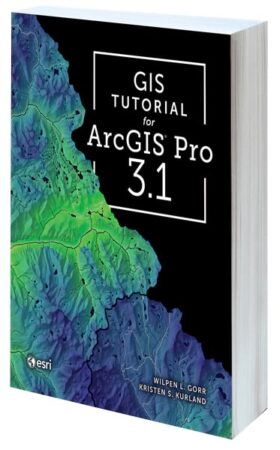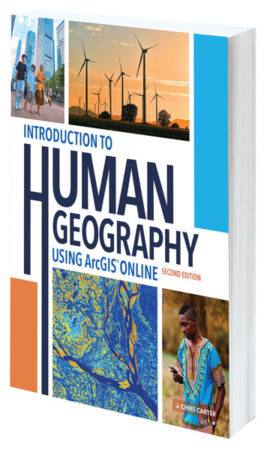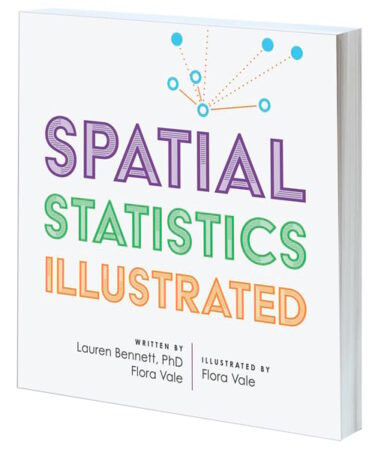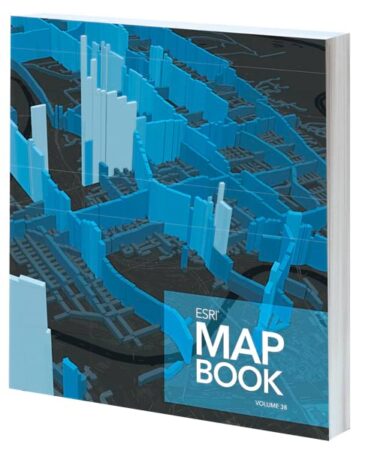Top 20 Essential Skills for ArcGIS Pro

By Bonnie Shrewsbury and Barry Waite
Get on the fast track to using desktop GIS with Top 20 Essential Skills for ArcGIS Pro. The book, written at an introductory level, features simple, step-by-step exercises that teach readers how to work with spatial data, create maps, and perform basic analysis. Each chapter introduces a skill, lets readers practice it, and includes a user story to show how these competencies are used to answer important questions and solve real-world problems. By the end of the book, readers understand what ArcGIS Pro is and how to use it and can leverage their newfound knowledge to continue their GIS journeys.
- May/September 2023, 190 pp.
- Ebook ISBN: 9781589487512
- Paperback ISBN: 9781589487505
GIS Tutorial for ArcGIS Pro 3.1

By Dr. Wilpen L. Gorr and Kristen S. Kurland
GIS Tutorial for ArcGIS Pro 3.1—the fifth edition in a series—is the book of choice for classroom-based and self-taught learners who seek to develop their expertise with Esri’s premier desktop GIS technology. Revised for ArcGIS Pro 3.1, the book features new datasets, exercises, and instructional text to guide readers through the latest tools and workflows. Authors Dr. Wilpen L. Gorr and Kristen S. Kurland use current, real-world scenarios to demonstrate how to make maps and find, create, and analyze spatial data using ArcGIS Pro and ArcGIS Online.
- May/September 2023, 312 pp.
- Ebook ISBN: 9781589487406
- Paperback ISBN: 9781589487390
Introduction to Human Geography Using ArcGIS Online, Second Edition

By Dr. J. Chris Carter
Introduction to Human Geography Using ArcGIS Online, Second Edition, brings the essential concepts and theories of human geography to life by integrating web maps into the subject matter. Dr. J. Chris Carter explains topics such as migration, race and ethnicity, food and agriculture, manufacturing and services, and cultural geography via exercises that allow readers to interact with, analyze, and create maps using ArcGIS Online. The book empowers learners to evaluate the diversity of people within their environments and their global impact.
- June/September 2023, 384 pp.
- Ebook ISBN: 9781589487475
- Paperback ISBN: 9781589487468
Addressing Earth’s Challenges: GIS for Earth Sciences

Edited by Dr. Lorraine Tighe and Matt Artz
In Addressing Earth’s Challenges: GIS for Earth Sciences, find out how organizations that work in geoscience, sustainable energy, environmental monitoring, climate science, meteorology, and marine science use GIS to streamline workflows, make decisions, boost operational efficiency, and foster civic inclusion. The book includes a section with ideas, strategies, tools, and actions to help readers jump-start their use of GIS for earth sciences. Online resources, including additional stories, videos, concepts, and downloadable tools, are also available.
- October 2023, 160 pp.
- Ebook ISBN: 9781589487536
- Paperback ISBN: 9781589487529
Spatial Statistics Illustrated

By Dr. Lauren Bennett and Flora Vale, illustrated by Flora Vale
Thanks to the vast amounts of data and incredible computational power that are now at people’s fingertips, data science has permeated nearly every aspect of life. But with so many algorithms and buzzwords floating around, it can be difficult to figure out where to start with solving complex problems. The good news is, there has never been a more exciting time to learn about spatial statistics, which employs geography to help quantify patterns, trends, and relationships. Spatial Statistics Illustrated helps readers learn the concepts behind the spatial statistics tools that are part of the ArcGIS system. Dr. Lauren Bennett and Flora Vale rely on approachable explanations and simple drawings to explain widely used spatial statistics methods, including how they work and when to employ them.
- June/September 2023, 176 pp.
- Ebook ISBN: 9781589485716
- Paperback ISBN: 9781589485709
Finding a Sustainable Balance: GIS for Environmental Management

Edited by Sunny Fleming and Matt Artz
As humans continue to uncover and learn about the ecological challenges being faced by the planet, environmental and natural resource management jobs are becoming increasingly difficult. Finding a Sustainable Balance: GIS for Environmental Management shows how GIS can improve operations across land and wildlife management, outdoor recreation, and environmental regulation. The book is a collection of real-life stories about how several environmental and natural resource management organizations successfully use GIS to monitor environmental assets in real time, prevent environmental hazards from turning into disasters, and provide transparency that produces better outcomes for everyone.
- June/September 2023, 125 pp.
- Ebook ISBN: 9781589487598
- Paperback ISBN: 9781589487581
Esri Map Book, Volume 38

By Esri Press
Every year, the works of mapmakers from around the world are selected for Esri Map Book to demonstrate how GIS technology helps governments, businesses, and individuals achieve their goals. The 38th volume in the series continues this tradition, showcasing maps and apps that employ ArcGIS technology to evaluate the sustainability of resources, determine efficient transportation routes, mitigate the effects of natural disasters, and much more. For each map or app that is included in the book, there is a description of its purpose and how it was produced.
- September 2023, 140 pp.
- Paperback ISBN: 9781589487444

